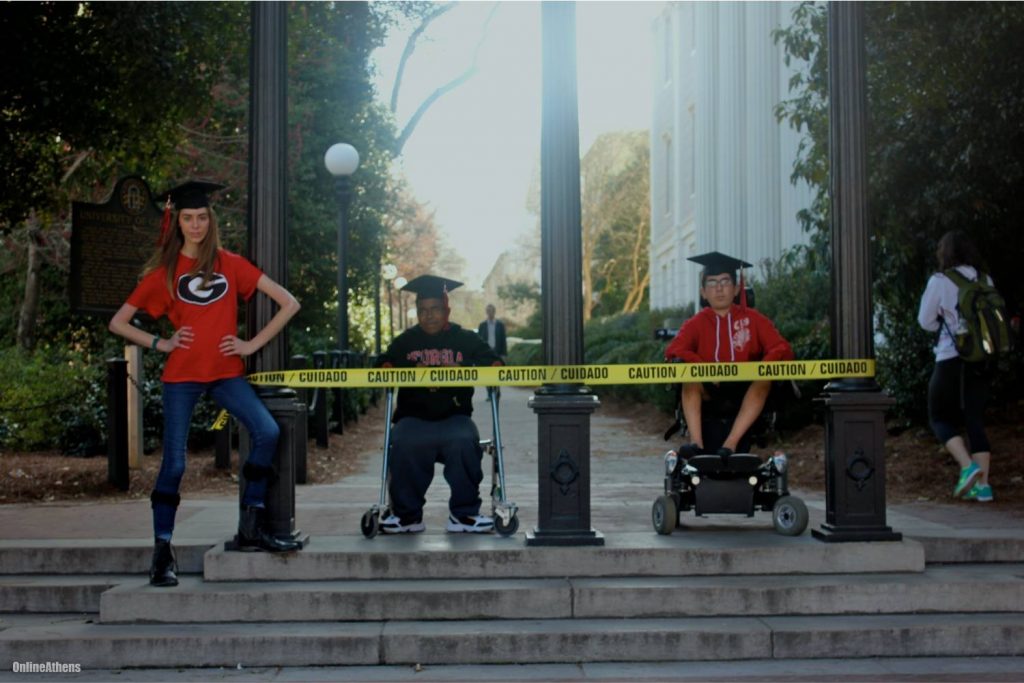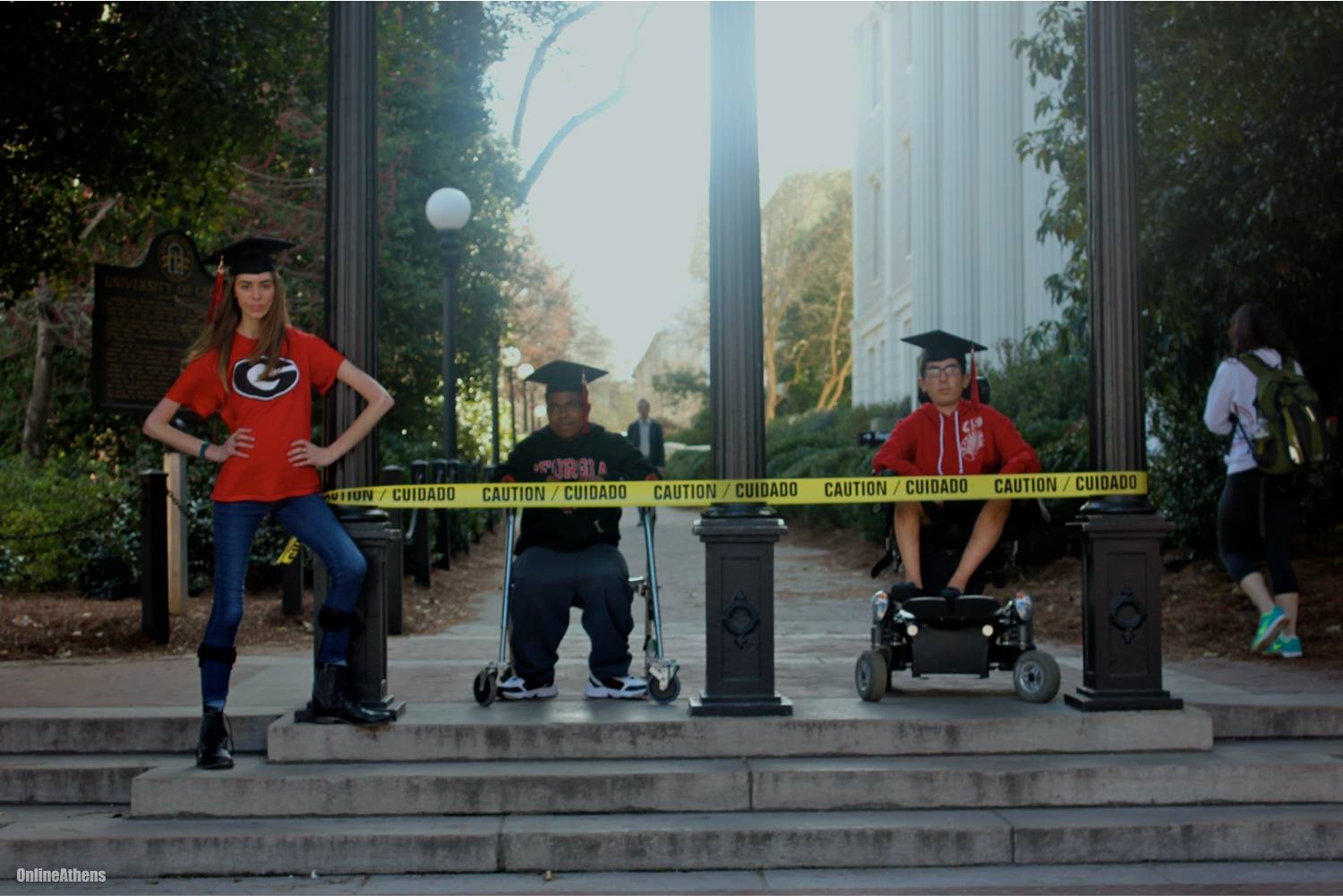By: Samantha Cleare

As May quickly approaches, UGA’s senior class is coming closer and closer to walking under the famous arch they’ve carefully sidestepped for four years. There are few traditions more important to the University of Georgia’s student body than passing through the arch after graduation. But sadly, some students are excluded from this symbolic rite of passage.
A portion of the student body cannot physically partake in this tradition, because they are disabled and cannot climb up the stairs that lead to the arch. Every few years, there is a call for a handicap ramp to be installed on the steps leading up to the arch to make it handicap-accessible. That call has remained unanswered, and now three students, Carden Wyckoff, Khaled Alsafadi, and Marquise Lane, spearhead a new campaign for equality.
Wyckoff, Alsafadi, and Lane’s campaign, “Make UGA’s Arch Accessible,” was launched in February of this year. It takes physically disabled students a quarter mile to avoid the arch’s stairs, because the only wheelchair accessible entrances to North Campus are on the back-end of the campus. With a ramp under the arch, students, and not to mention elderly visitors and alumni, using canes, walkers, and wheelchairs could travel to and from downtown with ease.
UGA’s Disability Resource Center helps create handicap options all over campus. The center’s website also provides students with maps and a way to report inconveniences. However, the arch stands without a handicap option. Carden Wyckoff states that due to her facioscapulohumeral muscular dystrophy, “stairs have become and continue to be difficult to walk up and down within the last five years. I can walk down stairs using a handrail for the most part but walking up stairs is much more difficult as I am working against gravity. Probably within the next few years I will be in a wheelchair and not be able to use stairs at all as there is no cure. Modifying the stairs would mean the world to me, as I would be able to partake in the tradition without the worries of falling or tripping on the stairs. In addition, I want all alumni, regardless of their mobility impairment, to be able to walk through the Arch with pride and confidence.” Wyckoff, along with the many other handicapped students at the University of Georgia, should be able to partake in this important tradition.
Senior Khaled Alsafadi, feels that a new ramp would not interfere with the aesthetics of the arch. Alsafadi also believes that most UGA students do not oppose the introduced handicap option. “We want to make it grander and more encompassing of the whole UGA family regardless of their mobility/disability. In doing so, we would make the arch live by the words that it symbolizes: wisdom, moderation, and JUSTICE. I hope that whoever oversees this project in the administration would stand by these words and give justice to all those from UGA’s past, present, and future who have some sort of mobility impairment, preventing them from partaking in this honorable historic tradition.”
The campaign continues to receive a generous amount of public outreach and support. Through a petition on change.org, the campaign’s supporters hope to find a permanent solution for this injustice. Thus far, the petition has gained more than 1,000 signatures. Only a few hundred more are required for the petition to reach Senator Saxby Chambliss. The campaign’s Facebook page received an overwhelming amount of positive responses. With more than 2,000 Facebook likes, “Making UGA’s Arch Accessible” continues to grab attention from all across the country. Both sources on and off campus have joined the conversation: UGA’s Grady News Source, the Red and Black, the Athens Banner-Herald, the Associated Press, the Marietta Daily Journal, the Augusta Chronicle, the Greenfield Daily Reporter, AJC, WRBL, and Fox 5 News have all positively spread the word.
Discussions with the Disability Resource Center, the Vice President of Student Affairs, the Associate Vice President for Facilities Planning, the Senior Associate Vice President of Finance and Administration, and the Dean of Students have all assisted in the campaign. The Disability Resource Center has been pushing for a handicapped option for years. With these students’ help, however, this proposition is finally making news.
Vice President of Student Affairs Victor Wilson has offered a temporary solution. He proposes constructing a makeshift ramp just for graduation day.
Supporters of “Make UGA’s Arch Accessible” will not settle for a temporary arrangement. Throughout UGA’s history, advancements in equality have been as prevalent as its game day culture. The University of Georgia, the first public university in the United States was founded in 1785 and admitted African-American students in 1961, long before many other universities in the United States. UGA has a long history of proactive reforms, which have continued to today. The question is, should students really settle for a temporary solution? Does this solution represent what it truly means to be a part of this longstanding institution? The university’s proud, progressive history suggests that a temporary fix will not suffice.
Students can participate in UGA’s many traditions ranging from ringing the Chapel Bell to cheering in Sanford Stadium. Walking under the arch is the most anticipated and honorable of these hallowed traditions. To past and present students, passing underneath this arch symbolizes a farewell to four years of college and an entrance into the rest of their lives. According to Marquise Lane, “If students with mobility impairments go through the same classes, do the same work, and get a degree like an able bodied person, we should be able to pass under the arch like an able bodied person.”
